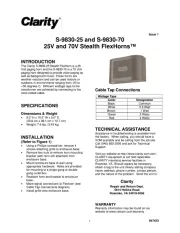Yamaha VXC5F Handleiding
Bekijk gratis de handleiding van Yamaha VXC5F (3 pagina’s), behorend tot de categorie Speaker. Deze gids werd als nuttig beoordeeld door 7 mensen en kreeg gemiddeld 4.1 sterren uit 4 reviews. Heb je een vraag over Yamaha VXC5F of wil je andere gebruikers van dit product iets vragen? Stel een vraag
Pagina 1/3

PLEASE READ CAREFULLY BEFORE PROCEEDING
* Please keep this manual in a safe place for future reference.
WARNING
Always follow the basic precautions listed below to avoid the possibility of
serious injury or even death f rom electrical shock, short-circuiting,
damages, fire or other hazards. T hese precaut ions include, but are not
limited to, the following:
• This device contains no user-serviceable parts. Do not open the device or
attempt to disassemble the internal parts or modify them in any way. If it
should appear to be malfunct ioning, discontinue use i mmediately and have it
inspected by qualified Yamaha service personnel.
• Do not expose the device to rain, use it near water or in damp or wet
conditions. If any liquid such as water seeps into the device, turn off the power
of the amplifier immediately and unplug the power cord from the AC outlet.
Then have the device inspected or repaired by qualified Yamaha service
personnel.
• Do not use burning items near the device. It may cause a fire.
• When one of the following problems occur, immediately turn off the power of
the amplifier.
- The power cord or plu g becomes frayed or damaged.
- It emits unusual smells or smoke.
- Some object has been dropped into the device.
- There is a sudden loss of sound during use of the devi ce.
- There are cracks or damage on the device.
Then have the device inspected by Yamaha service personnel.
CAUTION
Always follow the basic precautions listed below to avoid the possibility of
physical injury to you or others, or damage to the device or other prop erty.
These precautions include, but are not limit ed to, the following:
• Do not place the devi ce in an unstable posit ion where it might accidentally fall
over and cause inj uries.
• Do not place the device in a location where it may come into contact with
corrosive gases or salt ai r. Doing so may result in malfunct ion.
• Always consult a professional constructor if the de vice installation requires
construction work, and make su re to observe the following precautions.
- Choose mounting hardware and an installation location that can support the
weight of the device.
- Avoid locations that are exposed to constant vibration.
- Use the required tools to install the device.
- Inspect the device periodically.
• Before connecting the device to a power amplifier, turn off the power for all
devices. Before turning the power on or off for all devices, set all volume
levels to minimum. It may resu lt in electric shock, hearin g loss, or equipment
damage.
• Use only speaker cables for connecting speakers to the speaker jacks. Use of
other types of cables may result in fire.
PRECAUTIONS
Do not open
Water warning
Fire warning
If you notice any abnormality
Location
Connections
• Do not insert your fingers or hands in the moving part of the release lever/
bass reflex ports.
• Avoid inserting or dropping foreign objects (paper, plastic, metal, etc.) into any
gaps or openings on the devi ce (vents, disc slots, ports, etc.) If this happens,
turn off the power of the amplifier immediately and unplug the power cord
from the AC outlet. Then have the device inspected by qualified Yamaha
service personnel.
• Do not use the speakers for a long period of time at a high or uncomfortable
volume level, since t his can cause permanent hearing loss. If you experience
any hearing loss or ringing in the ears, consult a physician.
• Do not operate the device if the sound is distorting. Prolonged use in this
condition could cause ov erheating and result in fire.
• When choosing a power amplifier for use with this device, make sure that the
output power of the amplif ier is lower than the power capacity of this device
(see General Specifications). If the output power is higher than the power
capacity, malfunction or fire may occur.
• Do not input excessively loud signals that may result in clipping in the
amplifier or cause the following:
- Feedback, when using a microphone
- Continuous and extremely loud sound from a musical instrument, etc.
- Continuous and excessive loud distorted sound
- Noise caused by plugging/unplugging the cable while the amplifier is t urned
on
Even if the output power of the amplifier is lower than the power capacity of this
device (program), damage to the device, malfunction or fi re may occur.
NOTICE
To avoid the possibility of malfunction/damage to the product or damage to other
property, follow the notices below.
ƔHandling and maintenance
• When using a high-impedance speaker connection, make su re the audio
signal is passed through an 80 Hz or above high-pass filter before being input
to the speakers.
• Do not expose the device t o excessive dust or vibration, or extreme cold or
heat (such as in direct sunlight, near a heater, or in a car during the day), in
order to prevent the possibility of panel disfiguration, unstable operation, or
damage to the internal components.
• Do not place vinyl, plastic or rubber objects on the dev ice, since this might
discolor the panel.
• When cleaning the device, use a dry and soft cloth . Do not use paint thinners,
solvents, cleaning fluids, or chemical-impregnated wiping cloths.
• Condensation can occur in the devi ce due to rapid, drastic changes in
ambient temperature-when the device is moved from one location to another,
or air conditioning is turned on or off, for example. Using the device while
condensation is present can cause damage. If there is reason to believe that
condensation might have occurred, leave the device for several hours without
turning on power until the condensation has completely dried out.
• Be sure to observe the amplifier’s rated load impedance (see General
Specifications), particularly when connec ting speakers in parallel. Connecting
an impedance load outside the amplifier’s rated range can damage the
amplifier.
• Protection Circuit
This speaker system has an in ternal protection circuit that shuts off the
speaker unit when an excessive input signal is applied.
If the speaker unit emit s no sound, reduce the volume level of the amplifier
immediately. The sound will return automatically in several seconds.
• Air blowing out of the bass reflex ports is normal, and often occurs when the
speaker is handling program material with heavy bass content.
• Do not swing the speaker by its carrying band.
• Do not place the speaker face down with the grille attached, as deformation of
the grille may result.
• When placing the speaker face down, always place it on a fl at surface.
• Do not touch the speaker driver unit.
ƔAbout this manual
• T he illustrations as shown in this manual are for instructional purposes only .
• T he company names and product names in this manual are the trademarks or
registered trademarks of their respective compani es.
Yamaha cannot be held responsible for damage caused by improper use or
modifications to the devi ce.
Handling caution
Unpacking
Unpack the contents and confirm that all the following items are included.
* The speaker cable and safety wire are not included.
General Specifications
*1: Half-space (2π)
*2: Calculated based on power rating and sensitivity, exclusive of power compression.
The contents of this manual apply to the latest specifications as of the printing date. Since Yamaha makes continuous improvements to the product, this manual may
not apply to the specifications of your particular product. To obtain the latest manual, access the Yamaha website then download the manual file. Since specifications,
equipment or separately sold accessories may not be the same in every locale, please check with your Yamaha dealer.
The dimensions are shown in “Technical Specifications”.
• Speaker × 2 • O-ring × 2 • Cutout Template × 1
• Grille × 2 • Tile Rail × 4 • Owner’s Manual (this manual)
• Euroblock Plug (4-pin, 5.08 mm pitch) × 2 • Screw × 4 • Technical Specifications (English only)
• Terminal Cover (with 3 screws) × 2
VXC5F/VXC5FW VXC3F/VXC3FW
Type Full range, Bass reflex
Component 4.5” (11.5 cm) Full range unit 3.5” (9 cm) Full range unit
Coverage angle (1 kHz – 4 kHz on average) * 1130° conical 140° conical
Nominal impedance 8 Ω
Power rating NOISE 40 W 20 W
PGM 80 W 40 W
MAX 160 W 80 W
Sensitivity (1W, 1m) * 189 dB SPL 87 dB SPL
Maximum SPL (Calculated, 1m) * 2111 dB SPL 106 dB SPL
Frequency range (-10 dB) * 160 Hz – 20 kHz 71 Hz – 20 kHz
Connector Euroblock (4 pin) × 1 (input: +/-, loop-thru: +/-)
Max. wire size 12 AWG
Transformer taps 70 V 30 W, 15 W, 7.5 W, 3.8 W 15 W, 7.5 W, 3.8 W, 1.9 W
100 V 30 W, 15 W, 7.5 W 15 W, 7.5 W, 3.8 W
Overload protection Full-range power limiting to protect network and transducers
Magnetically shielded No
Enclosure Shape Round
Cabinet material ABS V-0, 3.5 mm, black
Baffle material ABS V-0, 5 mm, black
Grille Material Powder coated perforated steel (t=0.6 mm)
Trim Ring: ABS V-0
Aperture ratio: 46%
Finish VXC5F/VXC3F : Black painting (approximate value: Munsell N3)
VXC5FW/VXC3FW : White painting (approximate value: Munsell 9.3)
Dimensions (Including grille) Ø324 × 143D mm (Ø12-13/16" × D 5-11/16") Ø285 × 112D mm (Ø11-1/4" × D 4-7/16")
Net weight (Including grille) 3.1 kg (6.8 lbs) 2.5 kg (5.5 lbs)
Cutout size Ø285 mm (Ø11-1/4") Ø247 mm (Ø9-3/4")
Required ceiling board thickness 5 mm – 37 mm
Conduit tube Ø15.4 mm – Ø21.3 mm
Packaging Packaged in pair
Connecting the Cable
CAUTION
• When connecting with low impedance, take note of the total impedance.
• When connecting with high impedance, the total input wattages of the connected speakers should lie within the margin of the rated input of the power
amplifier. For more information, refer to the description concerning high impedance connection at the following URL.
Yamaha Pro Audio site “Better Sound for Commercial Installations”: http://www.yamahaproaudio.com/global/en/training_support/better_sound/
Using Loop-Through Terminals
For this method, cables are connected from terminals 1 and 4 to the
subsequent speaker. Cables with a thickness up to AWG 12 can be used. If
the Euroblock plug is disconnected from a speaker, all subsequent speakers
will not work. This can be useful to identify which speaker has a problem.
Paralleling Input Terminals
For this method, cables are connected to terminals 2 and 3 of each
speaker. Connect two cables to one terminal. Cables with a thickness up
to AWG 17 can be used. Since the cables are connected via Euroblock
plugs, subsequent speakers can work properly.
From amplifier or
previous speakers To subsequent
speakers
To
subsequent
speakers
Euroblock
plug
Power
amplifier
Speaker
From amplifier or
previous speakers
To subsequent
speakers
Power
amplifier
Speaker
Euroblock
plug
To
subsequent
speakers
Installing the Speakers
Install the speakers onto the ceiling with the supplied hardware. Ensure that
the strength of the ceiling rail is sufficiently strong.
Illustrations in this manual are for the VXC3F. The installation method is the
same for other models.
CAUTION
When attaching the speakers, turn off the power amplifier.
Pre-installation (Preparation of the Cable)
• Use stranded wire for cables attached to the Euroblock plug. Strip their
insulation as shown in the figure and connect them.
Note
Do not plate stranded wires by solder. Doing so will cause the wire to
break.
• Make sure that the release lever of the baffle front is in the position as
shown in the figure below.
1Put the supplied cutout template to the ceiling and draw a circle by
tracing it.
Make sure to use the cutout template so that hole is the correct
diameter.
Note
If you use a circular cutter, set the diameter with the cutout template.
2Cut the hole by tracing the circle.
Be careful to prevent chips or powder entering your eyes while
cutting the hole.
1Insert the two tile rails through the cut hole and place them on the
ceiling surface within your reach. Be sure that each tile rails are
oriented as shown below.
2Insert the folded O-ring through the cut hole and open it in the ceiling.
3Secure the O-ring and tile rails with supplied two screws through
either slot of both O-ring brackets.
1Cut Out a Hole in the Ceiling
2Install the Tile Rails and O-ring
About 7 mm (0.3 in.)
Maximum thickness of the cable 12 AWG
Release lever
O-ring
Tile rail
1Pull the wiring from the amplifier through the cut hole of the ceiling.
2Pass the cable through the terminal cover.
3After loosening the terminal screws of the Euroblock plug with a flat-
blade screwdriver, insert the cable into each terminal and tighten the
screws. For the connection, refer to “Connecting the Cable”. Make
sure that cables cannot be pulled out.
Note
Use a flat-blade screwdriver with a blade less than 3 mm (0.1 in.).
4Plug the connected Euroblock plug into the socket in the speaker.
5Tighten the screw and then attach the terminal cover.
3Connect the Wiring to the Connector
Euroblock plug
Terminal screw
Loosen
Flat-blade
screwdriver
Tighten
Less than 3 mm (0.1 in.)
1Take care not to trap the cable, carrying band, or safety wire while
slowly pushing the speaker up into the ceiling.
Make sure the release lever is in the position of the figure below. If it
is set to the position of the figure, when all the Anti-Drop tabs cross
over the O-ring, the speaker is held temporarily.
2While slightly lifting up the speaker, turn the screwdriver clockwise to
tighten the attachment screw.
The first turn of the attachment screw opens the clamp. Further turns
move the clamp down the channel to pull the speaker up into the
ceiling.
Note
When the clamp is difficult to open, turning the screwdriver halfway
counterclockwise once will make it easier to open the clamp.
CAUTION
• Do not over-tighten the attachment screw. Otherwise, the
attachment screw and clamp will break.
• Do not turn any screws other than attachment screw. Otherwise,
the speaker may fall or malfunction.
4Fix the Speakers onto the Ceiling
For safety, use the screw hole on the speaker (M5 × 12 mm) and
connect the wire to an independent support point such as a joist.
Example of the connection using an eye bolt
CAUTION
Always take measures to prevent the speaker from falling down.
Use a safety wire of appropriate length. Should the speaker fall and the
wire is too long, the wire may snap due to excess strain.
Safety wireEye bolt
Screw hole
(M5 × 12 mm)
Anti-Drop tab Carrying band
Release lever Anti-Drop tab
Fixing screw
Clamp
Select the line voltage/impedance (100 V/70 V/8Ω) and power tap for
100 V/70 V line distributed system, by rotating the tap selector switch on
the front side of the speaker with a flat-blade screwdriver.
CAUTION
• The “X” position should not be selected. The 8Ω position should be
selected for 8Ω audio systems only. If the setting is incorrect, it may
cause malfunction of the speaker and amplifier.
• Make sure the amplifier is switched off before operating the tap selector
switch.
Attach the string to the speaker as shown in the figure, then fit the grille to
the magnets (6 places) on the baffle front.
CAUTION
The grille may fall down if it is attached inadequately. Attach it firmly.
Removing from the Ceiling
1Loosen the fixing screw by turning the screw counterclockwise.
Loosen the screw and the clamp goes up, and as it reaches the top,
the clamp closes as shown in figure below.
2While slightly lifting up the speaker, secure it by moving the release
lever of the baffle front to the direction of the arrow as shown in the
figure.
3Remove the safety wire from the speaker that is detached from the
ceiling.
5Set the Line Voltage/Impedance and Power
6Attach the Grille
Clamp
Illustration indicates the setting at 15 W for 100 V
line and 7.5 W for 70 V line.
Magnet
Correctly attachedIncorrectly attached
Yamaha Pro Audio global web site:
http://www.yamahaproaudio.com/
Yamaha Manual Library:
http://www.yamaha.co.jp/manual/
Owner’s Manual
SPEAKER SYSTEM
English
ZP40630
EN DE
Auf der Rückseite befindet sich die deutsche Version der Bedienungsanleitung.

Dimensions
Unit: mm
Ø324
Ø279
143
130
VXC5F/VXC5FW
O-Ring
358565
Ø342
Ø282
Ø241
Ø285
112
100
VXC3F/VXC3FW
Tile Rail
608
644
38
28
32
VXC5F/VXC5FW VXC3F/VXC3FW
320565
Ø304
Ø244
Information for Users on Collection and Disposal of
Old Equipment
English
This symbol on the products, packaging, and/or accompanying
documents means that used electrical and electronic products should not
be mixed with general household waste.
For proper treatment, recovery and recycling of old products, please take
them to applicable collection points, in accordance with your national
legislation and the Directives 2002/96/EC.
By disposing of these products correctly, you will help to save valuable
resources and prevent any potential negative effects on human health and the
environment which could otherwise arise from inappropriate waste handling.
For more information about collection and recycling of old products, please contact your local
municipality, your waste disposal service or the point of sale where you purchased the items.
[For business users in the European Union]
If you wish to discard electrical and electronic equipment, please contact your dealer or
supplier for further information.
[Information on Disposal in other Countries outside the European Union]
This symbol is only valid in the European Union. If you wish to discard these items, please
contact your local authorities or dealer and ask for the correct method of disposal.
Verbraucherinformation zur Sammlung und Entsorgung
alter Elektrogeräte
Deutsch
Befindet sich dieses Symbol auf den Produkten, der Verpackung und/
oder beiliegenden Unterlagen, so sollten benutzte elektrische Geräte
nicht mit dem normalen Haushaltsabfall entsorgt werden.
In Übereinstimmung mit Ihren nationalen Bestimmungen und den
Richtlinien 2002/96/EC bringen Sie alte Geräte bitte zur fachgerechten
Entsorgung, Wiederaufbereitung und Wiederverwendung zu den
entsprechenden Sammelstellen.
Durch die fachgerechte Entsorgung der Elektrogeräte helfen Sie,
wertvolle Ressourcen zu schützen, und verhindern mögliche negative
Auswirkungen auf die menschliche Gesundheit und die Umwelt, die andernfalls durch
unsachgerechte Müllentsorgung auftreten könnten.
Für weitere Informationen zum Sammeln und Wiederaufbereiten alter Elektrogeräte
kontaktieren Sie bitte Ihre örtliche Stadt- oder Gemeindeverwaltung, Ihren
Abfallentsorgungsdienst oder die Verkaufsstelle der Artikel.
[Information für geschäftliche Anwender in der Europäischen Union]
Wenn Sie Elektrogeräte ausrangieren möchten, kontaktieren Sie bitte Ihren Händler oder
Zulieferer für weitere Informationen.
[Entsorgungsinformation für Länder außerhalb der Europäischen Union]
Dieses Symbol gilt nur innerhalb der Europäischen Union. Wenn Sie solche Artikel
ausrangieren möchten, kontaktieren Sie bitte Ihre örtlichen Behörden oder Ihren Händler
und fragen Sie nach der sachgerechten Entsorgungsmethode.
Information concernant la Collecte et le Traitement des
déchets d'équipements électriques et électroniques.
Français
Le symbole sur les produits, l'emballage et/ou les documents joints
signifie que les produits électriques ou électroniques usagés ne doivent
pas être mélangés avec les déchets domestiques habituels.
Pour un traitement, une récupération et un recyclage appropriés des
déchets d’équipements électriques et électroniques, veuillez les déposer
aux points de collecte prévus à cet effet, conformément à la
réglementation nationale et aux Directives 2002/96/EC.
En vous débarrassant correctement des déchets d’équipements
électriques et électroniques, vous contribuerez à la sauvegarde de
précieuses ressources et à la prévention de potentiels effets négatifs sur la santé humaine
qui pourraient advenir lors d'un traitement inapproprié des déchets.
Pour plus d'informations à propos de la collecte et du recyclage des déchets d’équipements
électriques et électroniques, veuillez contacter votre municipalité, votre service de
traitement des déchets ou le point de vente où vous avez acheté les produits.
[Pour les professionnels dans l'Union Européenne]
Si vous souhaitez vous débarrasser des déchets d’équipements électriques et
électroniques veuillez contacter votre vendeur ou fournisseur pour plus d'informations.
[Information sur le traitement dans d'autres pays en dehors de l'Union Européenne]
Ce symbole est seulement valable dans l'Union Européenne. Si vous souhaitez vous
débarrasser de déchets d’équipements électriques et électroniques, veuillez contacter les
autorités locales ou votre fournisseur et demander la méthode de traitement appropriée.
Inform
de Eq
inaprop
Para m
contac
cual us
[Para u
Si uste
vended
[Inform
Este sí
favor c
Inform
di vec
Per ult
ammin
dove L
[Per ut
Se Lei
rivendi
[Inform
Questo
articoli
smaltim
Inform
de eq
devido
Para o
contato
com o
[Para u
Se voc
fornec
[Inform
Este s
em con
de des
Technical Specifications
SPEAKER SYSTEM
ZQ16420

Product specificaties
| Merk: | Yamaha |
| Categorie: | Speaker |
| Model: | VXC5F |
Heb je hulp nodig?
Als je hulp nodig hebt met Yamaha VXC5F stel dan hieronder een vraag en andere gebruikers zullen je antwoorden
Handleiding Speaker Yamaha
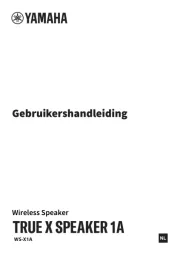
1 Augustus 2025
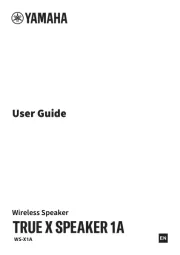
7 Juni 2025

4 Februari 2025

14 December 2024

2 December 2024

2 December 2024

2 December 2024

2 December 2024
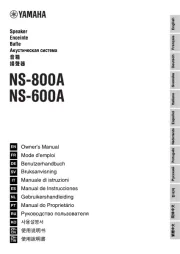
2 December 2024

2 December 2024
Handleiding Speaker
- ZyXEL
- Bose
- Techly
- Epcom
- Rega
- Q Acoustics
- Sonoro
- Korg
- Numan
- Mtx Audio
- Tellur
- Tascam
- Trust
- Energizer
- Sharp
Nieuwste handleidingen voor Speaker
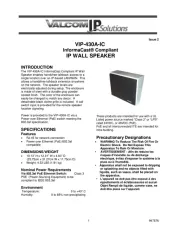
1 Augustus 2025
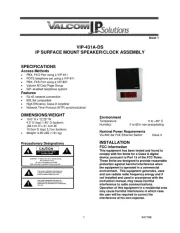
1 Augustus 2025
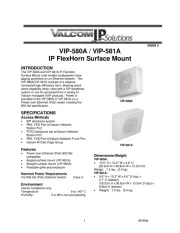
31 Juli 2025
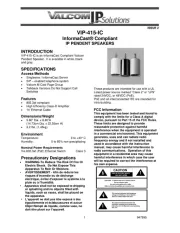
31 Juli 2025
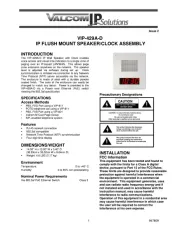
31 Juli 2025
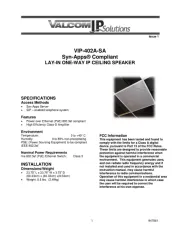
31 Juli 2025
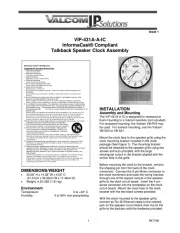
31 Juli 2025
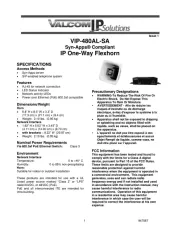
31 Juli 2025
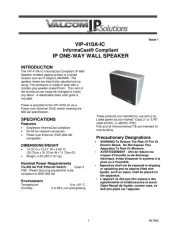
31 Juli 2025
